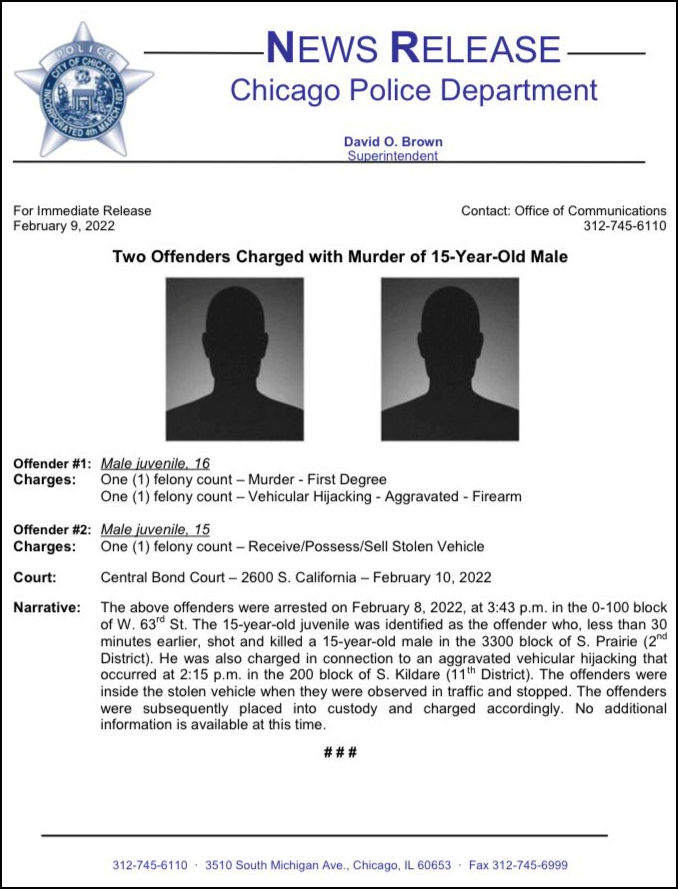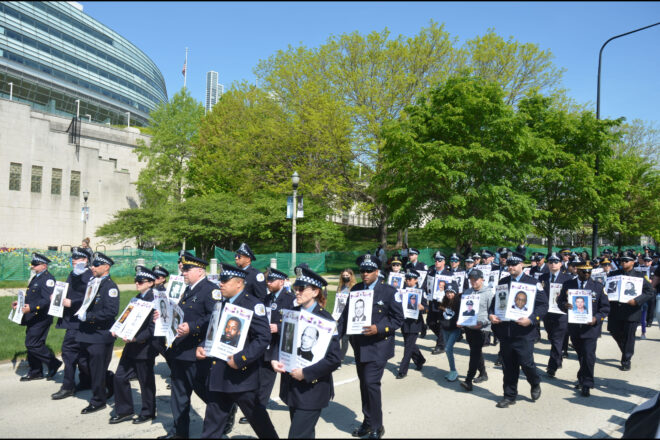The spectacle of lawlessness in Chicago is far too frequent, and far too often involves juvenile offenders and juvenile victims. On 9 February 2022, Chicago Police announced the arrest of a 16-year-old, Anthony Brown for the murder of a 15-year-old Michael Brown (known to Anthony, but not related). On 8 February 2022, Michael was shot twice in head, once in the shoulder, and once in the chest, as he walked home from school. Anthony Brown was driven to the shooting location by another 15-year-old juvenile offender in a vehicle Anthony Brown carjacked earlier in the afternoon from a Lyft ride-share driver. Before the carjacking, Anthony Brown had been in juvenile court on an ongoing case for his unlawful possession of a firearm last year. Police stopped the stolen vehicle with the two juvenile offenders about 30 minutes after the fatal shooting. Anthony Brown has been charged with first degree murder as an adult. The second juvenile offender was charged with possession of a stolen vehicle as a juvenile.
Estimated reading time: 4 minutes

Anthony Brown’s crime wave does not fit Chicago Mayor Lori Lightfoot’s “remote learning” connection narrative, which she tried to advance earlier in the week. However, his crime spree – in just one day – is yet another example of the truth about consequences. When accountability does not occur in the courthouse, the consequences play out in the streets. Because lawless places are violent places, those consequences are far too often deadly. This is as true with serious, chronic and violent juvenile offenders as it is with adult offenders.
While no motive was announced for the murder, the shooting was no accident. According to Chicago Police, Anthony Brown carjacked the stolen vehicle on Chicago’s west side at 2:15 p.m. Because Anthony Brown was on electronic monitoring, investigators were able trace his movements. The monitor’s GPS records showed that, within an hour of the carjacking, Anthony Brown drove to the area of Michael Brown’s school on the near south side of the city. The prosecutor from the Cook County State’s Attorney’s Office was reported by CBS Chicago as describing the following: “GPS data from the device showed Anthony Brown arrived at 3352 S. Prairie Ave. in the carjacked Lyft car at 3:13 p.m. Two minutes later, Michael Brown was walking home from school northward on the same block, and Anthony Brown – who had been driving south – turned around to catch up to him.” Anthony Brown had exited the passenger side of the carjacked vehicle and fired a total of nine shots.
Anthony Brown had been on and off of electronic monitoring since June 2021, when he was arrested for the unlawful possession of a handgun. He was taken off monitoring in July, but was put back on when he arrested for a December 2021 carjacking while he was again armed with a handgun.
The catch and release of juvenile offenders deeply engaged in delinquency, without actual intervention, is not effective. Not effective for the involved youth. Not effective for their families. Not effective for public safety. Not effective for their next victims. Simply not effective.
A “Cops Ask Questions” Reminder
In November 2022 our Editorial: Spectacle Chicago and the Death of the JISC made clear that Chicago had further weakened its response to juvenile crime with the closing of the city’s only Juvenile Intervention and Support Center (JISC). The city announced no plan for what it would do next. We encourage our readers to take a look back at the important editorial. Secure 1776 has three questions for the responsible elected officials – specifically, the state’s legislators (particularly those from Chicago), Governor J.B. Pritzker, Cook County Board President Toni Preckwinkle, Cook County State’s Attorney Kim Foxx, Cook County Chief Judge Timothy Evans, Mayor Lightfoot, and Chicago’s aldermen.
What is the plan to correct the catch and release approach with serious, chronic, and violent juvenile offenders being sent to court?
What is the plan to actually deliver effective interventions with juveniles early in their participation in delinquency?
When will public safety and crime victims be a true priority?
We are interested in your thoughts, and invite you to comment below.



What is the plan? Sadly there is no plan. While one young Brown kills another young Brown, ol’ David Brown is left to scratch his head & demand PCI’s & cancel all the officer’s days off & hope that makes it all go away.
Without question, there is a crisis in public safety in much of America. Chicago is clearly among those places where the crisis is most visible and urgent. Those leaders most responsible for ensuring public safety have much work to do. As the old saying goes: “When you fail to plan, you plan to fail.”
Yes, again and again the breakdown in the system (juvenile and adult) rears its ugly head. The insulting and ignorant speech Judge Timothy Evans gave just several weeks before at The City Club of Chicago addressed juvenile crime… He stated, “The court’s purpose in dealing with juveniles is to try to rehabilitate juveniles”. Agreed, but what is the plan? To let juvenile criminals go on “monitoring” with nothing else? Juveniles need structure and a knowledge (and yes FEAR) that their actions have consequences. Judge Evans then speaks with authority and with his vast knowledge of psychiatry. The judge preaches, “(juveniles) they don’t have the pre-frontal cortex that is developed, and the pre-frontal cortex of the brain, does not, itself fully developed until you’re closer to the age of 25 years of age, there’s no way that (they) he would have the prefrontal cortex already developed. So, while I can’t talk about that particular case, I’m just talking about the typical 16- year-old, he doesn’t have that part of the brain developed that makes it possible for him to distinguish between the right thing to do and the wrong thing to do.” Huh? We are not talking about a 5 or 6 year old pilfering a piece of candy from a grocery store… we are talking about serious and dangerous criminals. To reiterate… juveniles need structure and a knowledge (and yes FEAR) that their actions have consequences. Sadly I believe Judge Evans, and many of our so called leaders in the criminal justice system, don’t have the pre-frontal cortex that is fully developed either.
Absolutely spot on. Wwll said.
There is no plan, at the city, county and state level. That is why things like this will continue to happen.
We know what they say: “when you fail to plan; you plan to fail.”